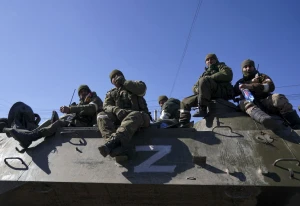
Explosions at Russian refineries, possible Ukraine-South Korea cooperation, situation near Borova. Serhiy Zgurets' column
The recap includes Ukrainian drone strikes on Russian territory, South Korea's key arsenal for Ukraine, and the situation on certain frontline areas
Strikes on Russian territory
On the night of June 20-21, another massive attack by Ukrainian drones on targets in the Russian Federation took place. According to video and open-source data, Ukrainian drones hit a number of Russian oil refineries, as well as Russian military facilities in the Bryansk region, Krasnodar Krai, and even Crimea.
A drone strike was carried out in the Krasnodar Krai, where the Yeysk airfield and a nearby training center are located. Later, the Ukrainian Armed Forces' General Staff detailed that the places of storage and preparation for the use of strike Shaheds, as well as training buildings, control and communication centers for the calculations of these unmanned systems were hit. In addition, according to the General Staff, strikes were launched against radar stations and electronic intelligence centers of the Russian invaders in the Bryansk region and the temporarily occupied Crimea.
Regarding the attacks on oil refineries by Ukrainian drones, there were reports of attacks on four Russian refineries. I would like to remind you that yesterday, Ukrainian long-range drones also struck two oil depots 300 and 400 kilometers from the front line in the Krasnodar Krai and Tambov Region. In general, we are talking about systematic work to destroy Russian oil and gas facilities as part of a war of attrition.
Cooperation with South Korea
Ukraine also has the opportunity to significantly strengthen its strike and defense capabilities through cooperation with South Korea. We know that the government of this country announced the lifting of the ban on arms transfers to Ukraine in response to the alliance between the Russian Federation and the DPRK. For Ukraine, South Korea is a potentially important partner that actively promotes arms to European markets, agrees to localize production and make rapid deliveries, and has samples of Soviet-made weapons.
All of this potential and opportunities were blocked for some time, although Kyiv had previously made a number of proposals to Seoul. Now we can return to these proposals again. First of all, Ukraine is interested in the supply and production of ammunition: Korea has significant stockpiles of these arsenals and has production lines, including gunpowder and explosives.
At the same time, we are interested in manufacturing barrels for our guns, which we received from foreign suppliers, as replacing them with new ones is an urgent need for Ukrainian Armed Forces. Negotiations or, better yet, licensed production of Korean missile systems Chunmoo K230 and K239 in Ukraine are extremely promising for us. This is actually an analog of the American HIMARS, although it is even more functional, as it has three calibers of rockets with a range of up to 80 km and two types of ballistic missiles like the American ATACMS with a range of 300 km. Poland has a contract for almost three hundred of these missile systems, with the involvement of its enterprises in the production of these systems in Poland. Romania, Sweden, and Norway also plan to buy them. In this sense, the purchase of such systems for Ukraine and the localization of their production is extremely important.
Korea also has its own air defense systems that are also capable of dealing with Russian ballistic missiles. These air defense systems are exported under the name L-SAM or Cheongung II - the systems can destroy Russian missiles and aerial ballistic targets at a distance of up to 80 km, and ballistic missiles can be destroyed at a distance of up to 30 km. This is an interesting and promising development that is already being exported to a number of countries.
Seoul also has illiquid weapons, including Russian armored vehicles that were once transferred by Russia to South Korea for debts. We are talking about 80 T-80U tanks, 70 BMW3s, and several dozen BTR-80s. Ukraine applied for the transfer of these samples in 2022, but was denied, but now their transfer is quite possible. All of this will be needed on the battlefield if South Korea is not afraid of Vladimir Putin's threats, who has already begun to scare Seoul with dire consequences if Ukraine supplies weapons.
Frontline situation
Now the Russian forces are trying to implement a strategy of a creeping offensive on the front line, based on the Russian superiority in personnel and a significant number of artillery, which is why the enemy is trying to break through Ukrainian defenses in several directions. In particular, Russians use the support of aviation with guided bombs.
One of the most difficult areas is the east of Kharkiv region, where the Russian forces have concentrated in Borova direction. The evacuation of children has been announced there, and the day before the Russians struck an Iskander missile at a bridge west of Borova on the Oskil River. They are now trying to push Ukrainian troops across the Oskil River along the entire line from Kupyansk to Kreminna, although it is unlikely to succeed, but they are making such attempts anyway.

Viktor Petrovych, a serviceman with the 77th Separate Airmobile Brigade, said that the Russian attacks in the direction of Borova near Novoselivske are constantly high.
"Over the past two months, the enemy has been storming our positions, conducting very active assault operations, using a lot of equipment - more than 141 units have been destroyed in the brigade's area of responsibility alone. We need to understand that the Borova area is not just our brigade. 141 pieces of equipment is a lot, including T-72 and T-80 tanks, a lot of infantry fighting vehicles, various KAMAZ trucks, and a Tor M2 air defense system. The Russian losses over the past month and a half in the area of our brigade's responsibility amount to 1,800 people - these are the dead and seriously wounded, who can be identified by drone. The intensity of the fighting is very high and they continue to gradually increase and increase the intensity, trying to deplete our defense resources, find weaknesses somewhere, perhaps at the junctions of different units and push us to Oskil," the fighter said.
According to him, the invading Russian forces are using a wide variety of equipment against the Ukrainian Defense Forces.
"These are armored infantry vehicles, armored personnel carriers, hiding behind tanks and tank sheds. In short, a lot of different equipment is used and therefore a lot is destroyed compared to the previous areas where our brigade was deployed. In particular, through FPV drones, for which we are raising funds, because it is difficult to destroy equipment with artillery, it can be blown up by minefields, but if they neutralize them, or even if it explodes, they can take this equipment back to their own, so to finish it off with FPV is a sacred cause to prevent the enemy from repairing it and putting it back into service," explained Viktor Petrovych.
Military mobilization
The soldier said the 77th Separate Airmobile Brigade has recruiting specialists.
"We are trying to recruit more motivated people who want to join our brigade, so we have opened a recruiting center. If you want to join a good brigade, you can join the 77th. At the moment, we have a very capable brigade, with coordinated actions of both the leadership and the soldiers. It is only through coordination and some military cunning that we are able to hold back the enemy, because the Russians actually outnumber us many times over," the soldier summarized.
Technologies at the front
The serviceman said that about 50% of drones are supplied by the state, but they often need to be adjusted to combat conditions.
"But the dynamics are good, and if the state continues to build up and not relax, it will have a significant impact on the war. We are saving money because it is still a limited resource. A lot of Russian personnel are coming to Ukrainian positions in waves. When the Russian troops get closer to the position, it is no longer possible to knock them out with artillery because they can hit their own, while FPV drones can hit the enemy 5-10 meters from the position, and it depends on this whether they will hold the position or not," he explained.
The 77th Separate Airmobile Brigade also has technical means to prevent the enemy from advancing, including anti-personnel and anti-tank mines.
"Our engineer sapper services cooperate with a company of striking unmanned aerial vehicles and have a solution to remotely mine the territory, because using sappers in the gray zone is always dangerous, and drones, for example, are not a pity," emphasized Viktor Petrovych.
Currently, the 77th Separate Airmobile Brigade is raising half a million hryvnias to purchase a company of unmanned aerial vehicles.
- News











































